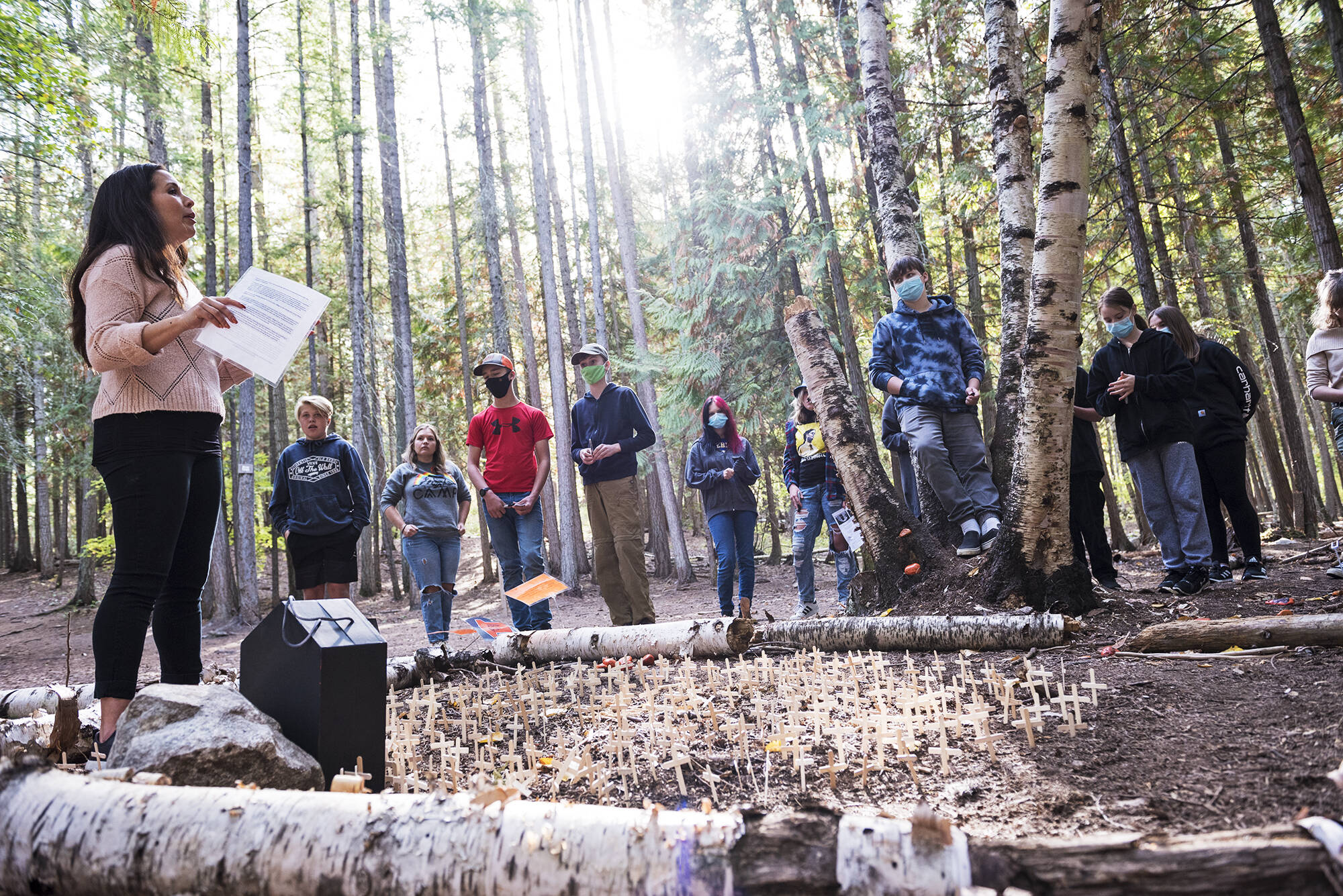A group of Shuswap Middle School Grade 8 students watch and listen as Kaeli Hawrys explains how to construct a model s7istcen or pit house.
After going over the basics of the four-post structure dug into the ground, Hawrys, one of the school’s Indigenous Education workers, explains how the pit house would have two entrances, one for the women, located at ground level and always facing the water. Men, she explained, would enter from above by log with steps carved into it in a unique pattern.
“With the men’s entrance, they would put different patterns for their staircases… and the reason they did this is so they would know when someone is trying to come into their pit house,” said Hawrys. “If you didn’t belong there, you wouldn’t know the step sequence… it was like an alarm system.”
This was a small part of a larger school project involving 27 classes being taught not in the classroom, but in Little Mountain Park.
“This year, in recognition of Orange Shirt Day (Sept. 30), we wanted to do a land-based activity with our children,” explained Indigenous Education Worker Theresa Johnson. “One of the most important things about Indigenous ways of knowing and being is that land is directly connected to identity and culture, so we wanted to get the kids out on the land learning about a traditional way of life.”
For part of the project, students constructed either a wigwam or pit house using wood, birch bark and moss found in the park, contributing to the creation of miniature model Indigenous villages. In the process, students learned how Indigenous families lived at one time and the connection they had to the land.
Centre to the villages is a model residential school. As part of the lesson, students were taken away from their villages and escorted to the school.
“Because we are within 300 kilometres of the residential school, you are the lucky bunch who gets to come home in the summer,” Hawrys told the students. “Students who were 700 to 1,000 kilometres away never got to come home for the summer. They were at residential schools from the ages of five to 17. You are going to be loaded up on a pig truck, a cattle truck, not a school bus, not in a vehicle, to go to the residential school.”
At the model residential school, Johnson explained parents didn’t have a choice about their children attending, and if they fought it they risked going to prison. She said upon arrival students would be given a haircut, explaining in a lot of Indigenous cultures, your hair is a part of your identity, a symbol of strength, that would only be cut when there was a loss in the family – the closer the cut, the closer the relation.
She recalled the story of a boy taken to residential school who, after having his head shaved had thought his mother had died.
Read more: B.C. public schools, government offices to close for Day of Truth and Reconciliation
Read more: Orange Shirt Society launches first textbook on residential school history
Johnson explained children would lose their real name, instead of being given an English name or, in some cases, a number.
“It would be the equivalent of us going to the school and them saying, you’re not going to speak English anymore, you’re not called what you are… And then repeatedly you are told, systematically, that your culture, your way of life, everything you know and understand, it’s not good enough, it’s not adequate, and you need to be taught a new and better way.”
Johnson said more than 150,000 Indigenous children were forcibly taken from their families to residential schools. Reflecting on the remains of the 215 children recently uncovered at the Kamloops Indian Residential School, Johnson noted that of the 139 residential schools in the country, so far only six have been searched and “they’ve already uncovered more than 2,000 children that are unmarked, undocumented, not on record.”
Johnson, however, stressed the focus shouldn’t just be on the past.
“It’s easy to mourn for little kids that never had the chance to grow up, or learn or have families,” said Johnson. “It’s harder to mourn for the people who are alcoholics, or thieves or homeless, or who aren’t good parents, who never parented properly.
“But they are also a result of residential school. And some of these kids grew up and what they learned in residential school was that they weren’t good enough, and that message has manifested in their lives in different ways.”
Afterwards, each student placed a small wooden cross at the model residential school, in recognition of the children that have been uncovered. By their villages, they place orange painted rocks, each offering a message of hope.
“We’re hopeful that people in the community will be able to come through and see their creations and enjoy the different villages the 27 classes have made,” said Johnson.
In addition to being Orange Shirt Day, this Thursday, Sept. 30, is also Canada’s first National Day for Truth and Reconciliation. Public schools in B.C. will be closed for the day.
lachlan@saobserver.netLike us on Facebook and follow us on Twitter
Sign up for our newsletter to get Salmon Arm stories in your inbox every morning.

